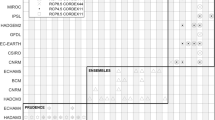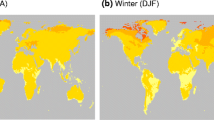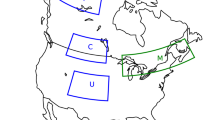Abstract
We review the ideas behind the pattern scaling technique, and focus on its value and limitations given its use for impact assessment and within integrated assessment models. We present estimates of patterns for temperature and precipitation change from the latest transient simulations available from the Coupled Model Inter-comparison Project Phase 5 (CMIP5), focusing on multi-model mean patterns, and characterizing the sources of variability of these patterns across models and scenarios. The patterns are compared to those obtained from the previous set of experiments, under CMIP3. We estimate the significance of the emerging differences between CMIP3 and CMIP5 results through a bootstrap exercise, while also taking into account the fundamental differences in scenario and model ensemble composition. All in all, the robustness of the geographical features in patterns of temperature and precipitation, when computed as multi-model means, is confirmed by this comparison. The intensity of the change (in both the warmer and cooler areas with respect to global temperature change, and the drier and wetter regions) is overall heightened per degree of global warming in the ensemble mean of the new simulations. The presence of stabilized scenarios in the new set of simulations allows investigation of the performance of the technique once the system has gotten close to equilibrium. Overall, the well established validity of the technique in approximating the forced signal of change under increasing concentrations of greenhouse gases is confirmed.





Similar content being viewed by others
Notes
MAGICC/SCENGEN user manual, p. 42, http://www.cgd.ucar.edu/cas/wigley/magicc/UserMan5.3.v2.pdf
The reader is referred to the IPCC Good Practice Guidance Paper on Multimodel Ensembles (http://www.ipcc-wg2.gov/meetings/EMs/IPCC_EM_MME_GoodPracticeGuidancePaper.pdf) for discussions and recommendations in interpreting multi-model results.
References
Annan JD, Hargreaves JC (2011) Understanding the CMIP3 multi-model ensemble. J Clim 24:4529–4538
Bouttes N, Gregory JM, Lowe JA (2013) The reversibility of sea level rise. J Clim 26:2502–2513
Cabre MF, Solman SA, Nunez MN (2010) Creating regional climate change scenarios over southern South America for the 2020’s and 2050’s using the pattern scaling technique: Validity and limitations. Clim Change 98(3–4):449–469
Chadwick R, Good P (2013) Understanding non-linear tropical precipitation responses to CO2 forcings. Geophys Res Lett 10:1029
Chadwick R, Wu P, Good P, Andrews T (2013) Asymmetries in tropical rainfall and circulation patterns in idealised CO2 removal experiments. Clim Dynam 40:295–316
Deser C, Phillips A, Bourdette V, Teng H (2012a) Uncertainty in climate change projections: the role of internal variability. Clim Dynam 38:527–546
Deser C, Knutti R, Solomon S, Phillips AS (2012b) Communication of the role of natural variability in future North American climate. Nat Clim Chang 2:775–779
Dessai S, Lu XF, Hulme M (2005) Limited sensitivity analysis of regional climate change probabilities for the 21st century. J Geophys Res Atmos 110(D19), D19108
Fischer EM, Schär C (2009) Future changes in daily summer temperature variability: Driving processes and role for temperature extremes. Clim Dynam 33:917–935
Fordham DA, Wigley TML, Brook BW (2011) Multi-model climate projections for biodiversity risk assessments. Ecol Appl 21(8):3317–3331. doi:10.1890/11-0314.1
Fowler HJ, Blenkinsop S, Tebaldi C (2007) Linking climate change modelling to impacts studies: Recent advances in downscaling techniques for hydrological modelling. Int J Climatol 27(12):1547–1578
Giorgi F (2008) A simple equation for regional climate change and associated uncertainty. J Clim 21(7):1589–1604. doi:10.1175/2007jcli1763.1
Good P et al (2012) A step-response approach for predicting and understanding non-linear precipitation changes. Clim Dynam 39:2789–2803
Good P, Gregory JM, Lowe JA, Andrews T (2013) Abrupt CO2 experiments as tools for predicting and understanding CMIP5 representative concentration pathway projections. Clim Dynam 40:1041–1053
Harris GR, Collins M, Sexton DMH, Murphy JM, Booth BBB (2010) Probabilistic projections for 21st century European climate. Nat Hazards Earth Syst Sci 10(9):2009–2020. doi:10.5194/nhess-10-2009-2010
Harris GR, Sexton DMH, Booth BBB, Collins M, Murphy JM, Webb MJ (2006) Frequency distributions of transient regional climate change from perturbed physics ensembles of general circulation model simulations. Clim Dynam 27(4):357–375
Hawkins E, Sutton R (2009) The potential to narrow uncertainty in regional climate predictions. Bull Am Meteorol Soc 90(8):1095–1107
Hawkins E, Sutton R (2011) The potential to narrow uncertainty in projections of regional precipitation change. Clim Dynam 37(1–2):407–418
Holden PB, Edwards NR (2010) Dimensionally reduced emulation of an AOGCM for application to integrated assessment modelling. Geophys Res Lett 37
IPCC (2013) Climate Change 2013. In: Stocker TF, Qin D, Plattner G-K, Tignor M, Allen SK, Boschung J, Nauels A, Xia Y, Bex V, Midgley PM (eds) The Physical Science Basis. Contribution of Working Group I to the Fifth Assessment Report of the Intergovernmental Panel on Climate Change. Cambridge University Press, Cambridge, United Kingdom and New York, NY, USA
Ishizaki Y, Shiogama H, Emori S, Yokohata T, Nozawa T, Ogura T, Abe M, Yoshimori M, Takahashi K (2012) Temperature scaling pattern dependence on representative concentration pathway emission scenarios. Climatic Change, In revision
Knutti R, Sedláček J (2013) Robustness and uncertainties in the new C 1 MIP5 climate model projections. Nat Clim Chang 3:369–373
Knutti R, Furrer R, Tebaldi C, Cermak J, Meehl GA (2010) Challenges in combining projections from multiple climate models. J Clim 23:2739–2758
Knutti R et al (2008) A review of uncertainties in global temperature projections over the twenty-first century. J Clim 21:2651–2663
Knutti R, Masson D, Gettelman A (2013) Climate model genealogy: Generation CMIP5 and how we got there. Geophys Res Lett 40:1194–1199
Lustenberger A, Knutti R, Fischer EM (2013) The potential of pattern scaling for projecting temperature-related extreme indices. Int J Climatol. doi:10.1002/joc.3659
Mahlstein I, Knutti R, Solomon S, Portmann RW (2011) Early onset of significant local warming in low latitude countries. Environ Res Lett 6:034009
Mahlstein I, Portmann RW, Daniel JS, Solomon S, Knutti R (2012) Perceptible changes in regional precipitation in a future climate. Geophys Res Lett 39, L05701
Manabe S, Wetherald RT (1980) Distribution of climate change resulting from an increase in CO2 content of the atmosphere. J Atmos Sci 37(1):99–118
Masson D, Knutti R (2011) Climate model genealogy. Geophys Res Lett 38, L08703
May W (2008) Climatic changes associated with a global “2 °C-stabilization” scenario simulated by the ECHAM5/MPI-OM coupled climate model. Clim Dynam 31(2–3):283–313
May W (2012) Assessing the strength of regional changes in near-surface climate associated with a global warming of 2°C. Clim Chang 110(3–4):619–644
Meehl GA, Washington WM, Ammann CM, Arblaster JM, Wigley TML, Tebaldi C (2004) Combinations of natural and anthropogenic forcings in twentieth-century climate. J Clim 17:3721–3727
Meehl GA, Covey C, Delworth T, Latif M, McAvaney B, Mitchell JFB, Stouffer RJ, Taylor KE (2007) The WCRP CMIP3 multimodel dataset - a new era in climate change research. Bull Am Meteorol Soc 88(9):1383–1394
Mitchell JFB, Johns TC, Eagles M, Ingram WJ, Davis RA (1999) Towards the construction of climate change scenarios. Clim Chang 41(3–4):547–581
Mitchell TD (2003) Pattern scaling - an examination of the accuracy of the technique for describing future climates. Clim Chang 60(3):217–242
Moss RH, Edmonds JA, Hibbard KA, Manning MR, Rose SK, van Vuuren DP, Carter TR, Emori S, Kainuma M, Kram T, Meehl GA, Mitchell JFB, Nakicenovic N, Riahi K, Smith SJ, Stouffer RJ, Thomson AM, Weyant JP, Wilbanks TJ (2010) The next generation of scenarios for climate change research and assessment. Nature 463(7282):747–756
Murphy JM, Booth BBB, Collins M, Harris GR, Sexton DMH, Webb MJ (2007) A methodology for probabilistic predictions of regional climate change from perturbed physics ensembles. Philos Trans R Soc A Math Phys Eng Sci 365(1857):1993–2028
Nakicenovic N, Alcamo J, Davis G, de Vries B, Fenhann J, Gaffin S, Gregory K, Grubler A, Jung T, Kram T, La E, Michaelis L, Mori S, Morita T, Pepper W, Pitcher H, Price L, Riahi K, Roehrl A, Rogner H, Sankovski A, Schlesinger M, Shukla P, Smith S, Swart R, van Victor NS, Dadi Z (2000) Special report on emissions scenarios: A special report of Working Group III of the intergovernmental panel on climate change. C.U. Press, Cambridge, p 599
Neelin JD, Munnich M, Su H, Meyerson JE, Holloway CE (2006) Tropical drying trends in global warming models and observations. Proc Natl Acad Sci U S A 103(16):6110–6115
Raisanen J, Ruokolainen L (2006) Probabilistic forecasts of near-term climate change based on a resampling ensemble technique. Tellus Ser A Dyn Meteorol Oceanogr 58(4):461–472
Ruosteenoja K, Tuomenvirta H, Jylha K (2007) GCM-based regional temperature and precipitation change estimates for Europe under four SRES scenarios applying a super-ensemble pattern-scaling method. Clim Chang 81(1):193–208
Sanderson BM, Knutti R (2012) On the interpretation of constrained climate model ensembles. Geophys Res Lett 39, L16708
Sanderson MG, Hemming DL, Betts RA (2011) Regional temperature and precipitation changes under high-end (> = 4 °C) global warming. Philos Trans R Soc A Math Phys Eng Sci 369(1934):85–98
Santer BD, Wigley TML, Schlesinger ME, Mitchell JFB (1990) Developing climate scenarios from equilibrium GCM results, Hamburg, Germany
Schlesinger ME, Malyshev S, Rozanov EV, Yang FL, Andronova NG, De Vries B, Grubler A, Jiang KJ, Masui T, Morita T, Penner J, Pepper W, Sankovski A, Zhang Y (2000) Geographical distributions of temperature change for scenarios of greenhouse gas and sulfur dioxide emissions. Technol Forecast Soc Chang 65(2):167–193
Seneviratne SI, Lüthi D, Litschi M, Schär C (2006) Land-atmosphere coupling and climate change in Europe. Nature 443:205–209
Shiogama H, Hanasaki N, Masutomi Y, Nagashima T, Ogura T, Takahashi K, Hijioka Y, Takemura T, Nozawa T, Emori S (2010) Emission scenario dependencies in climate change assessments of the hydrological cycle. Clim Chang 99(1–2):321–329
Shiogama H, Stone DA, Nagashima T, Nozawa T, Emori S (2012) On the linear additivity of climate forcing-response relationships at global and continental scales. International Journal of Climatology
Solomon S, Plattner GK, Knutti R, Friedlingstein, P (2009) Irreversible climate change due to carbon dioxide emissions. Proc Natl Acad Sci U S A, 106(6):1704–1709
Taylor KE, Stouffer RJ, Meehl GA (2012) A summary of the CMIP5 experiment design. Bull Am Meteorol Soc 93:485–498
Tebaldi C, Arblaster JM, Knutti R (2011) Mapping model agreement on future climate projections. Geophys Res Lett 38, L23701
Tebaldi C, Knutti R (2007) The use of the multi-model ensemble in probabilistic climate projections. Philos Trans R Soc A 365:2053–2075
van Vuuren DP, Edmonds J, Kainuma M, Riahi K, Thomson A, Hibbard K, Hurtt GC, Kram T, Krey V, Lamarque JF, Masui T, Meinshausen M, Nakicenovic N, Smith SJ, Rose SK (2011) The representative concentration pathways: An overview. Clim Chang 109(1–2):5–31
Watterson IG (2008) Calculation of probability density functions for temperature and precipitation change under global warming. J Geophys Res Atmos 113(D12), D12106. doi:10.1029/2007JD009254
Watterson IG, Whetton PH (2011) Joint PDFs for Australian climate in future decades and an idealized application to wheat crop yield. Aust Meteorol Oceanogr J 61:221–230
Wu P, Wood R, Ridley J, Lowe J (2010) Temporary acceleration of the hydrological cycle in response to a CO2 rampdown. Geophys Res Lett 37(12):L12705
Acknowledgments
We thank the editors, Dr. Tom Wigley, Dr. Reto Knutti and two anonymous reviewers for their comments and suggestions.
We acknowledge the modeling groups, the Program for Climate Model Diagnosis and Intercomparison, and the Working Group on Coupled Modeling of the World Climate Research Programme (WCRP) for their roles in making available the WCRP CMIP3 and CMIP5 multimodel datasets. Support of these datasets is provided by the Office of Science, US Department of Energy (DOE). Portions of this study were supported by the Office of Science, Biological, and Environmental Research, US DOE (Grant DE-SC0004956 and Cooperative Agreement No. DE-FC0297ER62402). The National Center for Atmospheric Research is funded by the National Science Foundation.
Author information
Authors and Affiliations
Corresponding author
Additional information
This article is part of the Special Issue on “A Framework for the Development of New Socio-economic Scenarios for Climate Change Research” edited by Nebojsa Nakicenovic, Robert Lempert, and Anthony Janetos.
Electronic supplementary material
Below is the link to the electronic supplementary material.
ESM 1
(DOCX 3083 kb)
Rights and permissions
About this article
Cite this article
Tebaldi, C., Arblaster, J.M. Pattern scaling: Its strengths and limitations, and an update on the latest model simulations. Climatic Change 122, 459–471 (2014). https://doi.org/10.1007/s10584-013-1032-9
Received:
Accepted:
Published:
Issue Date:
DOI: https://doi.org/10.1007/s10584-013-1032-9




